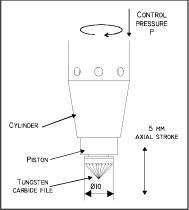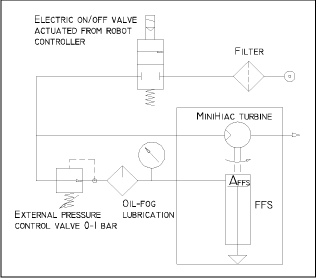Mini Hiac Operation/Specifications
 The FFP or Free Flying Piston,
is an important part of the Mini Hiac. The FFP or Free Flying Piston,
is an important part of the Mini Hiac.
The FFP is pushed
forward into contact with the burr edge by use of a remotely controlled air
pressure. The air vane motor is decoupled from the linear movement of the
FFP, to reduce inertia and increase the stability of the contact force when
deburring. The spline coupling transmits torque to the rotary file.
Ball bearings ensure
an even running of the tungsten carbide file. A very little friction torque
is transmitted through the ball bearings to the FFP cylinder, which rotates
slowly inside the stationary outer cylinder. Thus stick-slip or static friction
of the FFP is avoided. The FFP cylinder is in addition precision ground to
ensure very little friction in the axial direction.

The pneumatic connection
diagram for the Mini Flexdeburr is shown to the right.
Conventional pneumatic
components (not part of the Mini Flexdeburr machine delivery) are used to
control the air supply to the Mini Flexdeburr. We recommend the user
install a pneumatic regulator in connection with the air supply to the deburring
installation in order to achieve a stable air supply and to reduce the air
supply to maximum 6 bar.
The electric on/off valve
is actuated from the robot controller by means of a digital output signal.
The intention of the external
pressure control valve (actually a regulator) is to control the air
supply to the axial force compliance mechanism, thus enabling control of the
axial force on the rotary burr. If the complete work piece can be deburred
with equal axial force, a conventional manual pressure regulator can be used.
If the burrs to be removed are varying from spot-to-spot on the work piece,
and this variation is repeatable for all work pieces of the same type, it
might be necessary to adjust the axial force for different spots on the
work piece. This adjustment can be performed by means of an analog
pressure regulator, controlled from the robot controller. An analog
output port in the robot controller will be needed. As an alternative,
several digital outputs may be coupled to a digital to analog converter
(D/A converter). 4-20 mA type signals are preferred.
Specifications:
- Motor: Air motor, vane type.
- Speed: Idle 33,000 rpm, operating
22-27,000 rpm.
- Torque: 0.025 Nm at 27,000 RPM
tool speed
- Power: 70 W at 27,000 rpm tool
speed.
- Weight total: 0.512 kg.
- Weight FFP with file: 30-35 g.
- Compensation, due to burr inaccuracy:
max. +/-2.5 mm in/out and sideways, recommended to use +/-1.25 mm.
- Axial force: 0.3-8 N, by
pressure 0-1 bar.
- File surface speed: 5.8-7.1 m/sec
measured at 5mm diam. (halfway between tip and outer rim).
- Air consumption: Appr. 230 I/min.,
5 bar pressure.
- Sound pressure level: 75 dB(A).
- Sound pressure value: 87 dB(C).
- Rotary burrs: Diameter 10 mm standard.
(1)90° coned shape, straight fluting.
- Other rotary burr/file qualities
on request
- Special tools: Burr change tool
(part no. 43770). Hook spanner (part no. 5432)
Top
/ Return to main Mini Hiac page
/ Return to main Speedeburr page
|